Last month I explained why we’ve made changes to our Normandy tour. This month is my chance to tell you all about it.
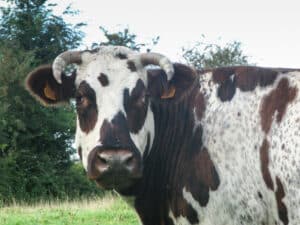
First off, I’m delighted. When I first researched around Normandy, back in 2011, it was a real eye-opener for me. Because of its position, just over the English Channel, I think I’d come to regard Normandy as somewhere I drove through on my way to France.
That’s just wrong, and I’m delighted that we’re up-and-running in Normandy again. So, what are my favourite bits of our new tour? Well, it turns out there are too many things that are too interesting. I had to stop writing and remember to focus a bit!
So I’m going to start with the Mulberry Harbour that can still be seen at Arromanches, one of the Normandy Landing Beaches. During the course of our week, we spend some time in the Pays d’Auge exploring the beautiful timbered architecture, apple orchards, the cheese, creamy sauces, cider and calvados that the French think Normandy is famous for (but which most of us have never heard of).
We also explore the story of William the Conqueror, once known as William the Bastard, who changed his name to William the King of England thanks to a flukey arrow that smote King Harold at the Battle of Hastings.
And we get to explore the incredible story of Operation Overlord, the Normandy Landings in June 1944.
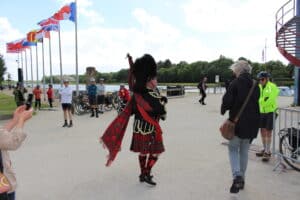
One of the aspects of Operation Overlord that most fascinates me is the way that individual challenges were broken into separate challenges for the Americans / British / Canadians / Polish to figure out. So there was a plan for scaling the cliffs at the Pointe du Hoc. There was a plan to capture the bridges over the river and canal between Caen and Ouisterham. There was a plan for the transport of oil across the English channel. And there was a plan for getting all those soldiers, vehicles and stores onto the beaches of Normandy.
The problem is that you can’t land many people and equipment directly onto the beach, you need a port. So in 1943, primarily Canadian troops attacked Dieppe, to test the feasibility of capturing and holding a port. It didn’t go well.
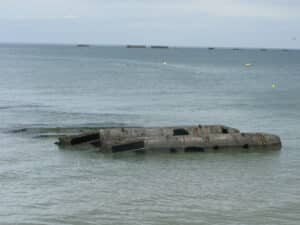
After Dieppe, the Allies concluded that they couldn’t capture a port; they’d have to take one with them. And so the operation to build transportable temporary harbours was launched. I keepswitching between ‘it’ and ‘them’. These were the Mulberry Harbours, but one was so badly damaged in the storms thatfollowed the landings that it was mostly used for spares. The other became the largest port in the world for the next 4 months, and huge parts of the harbour can still be seen in and around Arromanches.
The detail is fascinating, it was an incredible project, far too big for me to do justice to here. You’ll find more information here, and it is worth it. In brief, a huge breakwater, 5 miles long, was formed by sinking old ships and concrete caissons in a semi-circle off the coast. Within the breakwater a harbour was built, with landing piers, a central platform, and roadways leading onto the beach at Arromanches.
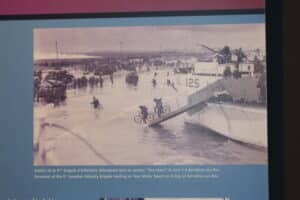
There were 400 separate components to the harbour, weighing a total of 1.5 million tons! The roads leading to the beach were each a mile long. It was an incredible undertaking. And you can still see much of it today.
From the cliffs approaching Arromanches you get a fabulous view of many caissons, sunk in place to form the breakwater. They look quite close to the shore, an easy swim, but these 6,000 ton concrete blocks are 3 miles out!
Some of them are washed-up and crumbling on Arromanches beach. The museum at Arromanches is one of my favourite places in Normandy. It explains in detail how it all worked, and how tiny Arromanches became the world’s busiest port.
Actually, my favourite momemt in Arromanches has nothing to do with the Mulberry harbour. A few years ago Scots Tom and Elspeth Wilson arrived on holiday direct from Turkey. They’d been to the bank in Turkey for their Euro, and been given a 500 Euro note! We tried to change it in a bank, they just refused. Absolutely true.
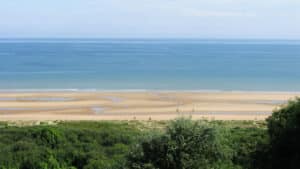
There were 10 of us, with me, so Tom and I had taken to going into each memorial or museum, acting as if butter wouldn’t melt, asking for 10 tickets and handing over Tom’s 500 Euro note, “all nonchalant like”, as Corporal Jones might have said in Dad’s Army. Nobody was interested. Until we got to Arromanches. God bless ’em, they didn’t bat an eyelid, just gave us change for €500.
From 2023, once we’ve finished exploring Arromanches, we’re done for the day. Instead of pushing on to Bayeux, we cycle just a few metres to the Hotel les Villas d’Arromanches (Bayeux is tomorrow).
Like a lot of changes that I make to our tours, I ask myself ‘Why didn’t we always stay here?’ It’s a shorter day, a better day, with time for a swim in the sea.


